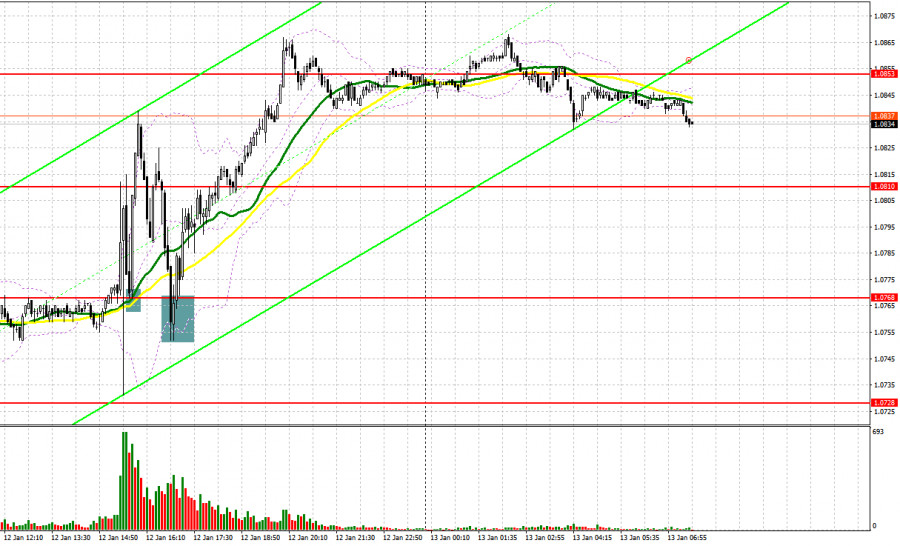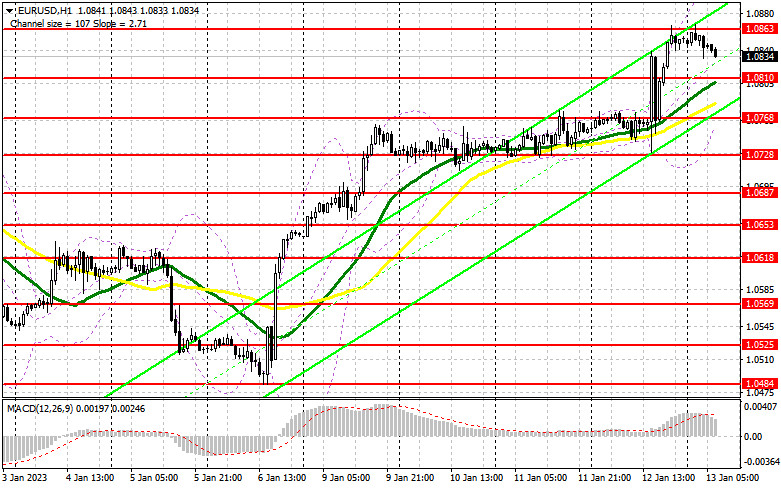
Yesterday, there were a couple of great signals. Let us have a look at the 5-minute chart and figure out what happened. Earlier, I highlighted the level of 1.0755 and recommended making market entry decisions with this level in mind. Falling to 1.0755 did not produce a buy signal because the pair crossed this level at the first test. However, bears didn't get support from the big players and by the middle of the day the bulls regained control over this mark. A retest created a buy signal, but it did not result in an uptrend. During the US session, a false breakout at 1.0768 produced a buy signal, and EUR moved up by 70 pips. The second time, the same false breakout and a buy signal made it possible for the bulls to reach resistance at 1.0853.

When to go long on EUR/USD:
US inflation is consistently slowing down. This kind of news makes us believe that the Federal Reserve will become less aggressive by the end of the year, which will only increase the demand for risky assets like the euro. Several reports will be released today, which are of little interest due to their irrelevance. The reports are for November 2022, so it's fine if you just read the figures and nothing more. They will not lead to any major market changes. These are data on eurozone industrial production and euro area balance of trade. To open longs, make sure that the bulls are around the nearest support at 1.0810. At this level, the moving averages are benefiting the bulls. In case EUR falls here, a false breakout would give a buy signal, with the prospect of hitting the monthly high at 1.0863, which was formed yesterday. A breakout and a downward test of this level can take place if we receive strong eurozone data. It will create an additional buy signal with the prospect of a jump to 1.08940, which will stimulate the formation of a bullish trend. A breakout of this level will also force bears to Stop Loss orders and give an additional buy signal. The pair could advance to 1.0931, where I recommended locking in profits. If EUR/USD drops and bulls show no activity at 1.0810 during the European session, the pressure on the pair will increase. Therefore, it is better to pay attention to the support level of 1.0768. Only a false breakout of this level will provide a buy signal. You could open long positions at a bounce from a low of 1.0728 or 1.0687, keeping in mind an upward intraday correction of 30-35 pips.
When to go short on EUR/USD:
Bears remain on the sidelines, because so far all the data is against them. Considering today's reports, there is nothing to count on. If EUR/USD rises during the European session, it is better to open short positions after an unsuccessful consolidation above the new monthly high of 1.0863, this will result in a sell signal against the trend and a fall to 1.0810. Bulls and bears are likely to tussle for this level as moving averages benefiting bulls are passing below this level. A breakout and an upward test of this level could significantly undermine bullish prospects, escalating pressure on the euro. It will give a new sell signal with the prospect of reaching 1.0768. Settling below this mark can push the pair to fall towards 1.0728. A more distant target will be 1.0687. A test of this level will indicate the formation of a bear market. I recommend locking in profits there. If EUR/USD grows during the European session and bears show no energy at 1.0863, I would advise you to postpone short positions until 1.0894. You could sell EUR/USD at a bounce from 1.0931, keeping in mind a downward intraday correction of 30-35 pips.

COT report:
The COT report (Commitment of Traders) for January 3 logged a sharp drop in both long and short positions. Traders preferred to lock in profits at the start of the year due to uncertainty over the further policy decisions of the Fed and the ECB. Inflation is starting to slow down. This is why it is high time to abandon aggressive tightening. However, the Fed will hardly do that. Traders are concerned that monetary tightening could trigger a recession in the global economy this year. For this reason, demand for risky assets is limited. Apart from that, traders are now anticipating the US inflation report. It is likely to provide more clues about the Fed's future plans for monetary policy. Fed Chairman Jerome Powell's speech this week is likely to be devoted to this problem. The COT report revealed that long non-commercial positions decreased by 29,344 to 222,543, while short non-commercial positions fell by 13,097 to 92,628. At the end of the week, the total non-commercial net position declined sharply and amounted to 129,915 against 142,279. It appears investors are still opening long positions on the euro despite uncertainty over the ECB's steps on monetary policy. They are betting on a policy reversal this year. However, the euro needs new drivers for further growth. The weekly closing price slid to 1.0617 against 1.0690.
Indicator signals:
Moving averages
Trading is carried out above the 30 and 50 daily moving averages. It indicates that bulls are trying to cement the upward movement.
Note: The period and prices of moving averages are viewed by the author on the hourly chart and differ from the general definition of classic daily moving averages on the daily chart.
Bollinger Bands
If EUR/USD rises, the indicator's upper limit at 1.0894 will serve as resistance. In case of a drop, the indicator's lower limit at 1.0768 will act as support.
Indicator description:
Moving average (MA) determines the current trend by smoothing volatility and noise. Period 50. Colored yellow on the chart.Moving average (MA) determines the current trend by smoothing volatility and noise. Period 30. Colored green on the chart.Moving Average Convergence/Divergence (MACD). Fast EMA 12. Slow EMA 26. SMA 9.Bollinger Bands. Period 20Non-commercial traders are speculators such as individual traders, hedge funds, and large institutions who use the futures market for speculative purposes and meet certain requirements.Long non-commercial positions are the total long position of non-commercial traders.Non-commercial short positions are the total short position of non-commercial traders.Total non-commercial net position is the difference between the short and long positions of non-commercial traders.